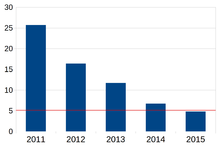Feasibility of artificial superintelligence
Progress in machine classification of images
The error rate of AI by year. Red line - the error rate of a trained human
The error rate of AI by year. Red line - the error rate of a trained human
Concerning human-level equivalence, Chalmers argues that the human brain is a mechanical system, and therefore ought to be emulable by synthetic materials.[6] He also notes that human intelligence was able to biologically evolve, making it more likely that human engineers will be able to recapitulate this invention. Evolutionary algorithms in particular should be able to produce human-level AI.[7] Concerning intelligence extension and amplification, Chalmers argues that new AI technologies can generally be improved on, and that this is particularly likely when the invention can assist in designing new technologies.[8]
If research into strong AI produced sufficiently intelligent software, it would be able to reprogram and improve itself – a feature called "recursive self-improvement". It would then be even better at improving itself, and could continue doing so in a rapidly increasing cycle, leading to a superintelligence. This scenario is known as an intelligence explosion. Such an intelligence would not have the limitations of human intellect, and may be able to invent or discover almost anything.
Computer components already greatly surpass human performance in speed. Bostrom writes, “Biological neurons operate at a peak speed of about 200 Hz, a full seven orders of magnitude slower than a modern microprocessor (~2 GHz).”[9] Moreover, neurons transmit spike signals across axons at no greater than 120 m/s, "whereas existing electronic processing cores can communicate optically at the speed of light". Thus, the simplest example of a superintelligence may be an emulated human mind that's run on much faster hardware than the brain. A human-like reasoner that could think millions of times faster than current humans would have a dominant advantage in most reasoning tasks, particularly ones that require haste or long strings of actions.
Another advantage of computers is modularity, that is, their size or computational capacity can be increased. A non-human (or modified human) brain could become much larger than a present-day human brain, like many supercomputers. Bostrom also raises the possibility of collective superintelligence: a large enough number of separate reasoning systems, if they communicated and coordinated well enough, could act in aggregate with far greater capabilities than any sub-agent.
There may also be ways to qualitatively improve on human reasoning and decision-making. Humans appear to differ from chimpanzees in the ways we think more than we differ in brain size or speed.[10] Humans outperform non-human animals in large part because of new or enhanced reasoning capacities, such as long-term planning and language use. (See evolution of human intelligence and primate cognition.) If there are other possible improvements to reasoning that would have a similarly large impact, this makes it likelier that an agent can be built that outperforms humans in the same fashion humans outperform chimpanzees.[11]
All of the above advantages hold for artificial superintelligence, but it is not clear how many hold for biological superintelligence. Physiological constraints limit the speed and size of biological brains in many ways that are inapplicable to machine intelligence. As such, writers on superintelligence have devoted much more attention to superintelligent AI scenarios.[12]
end quote from:
https://en.wikipedia.org/wiki/Superintelligence
subheading:
Feasibility of artificial superintelligenc

No comments:
Post a Comment